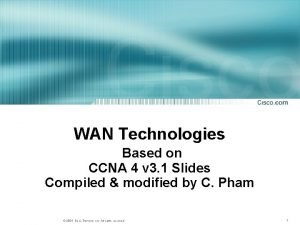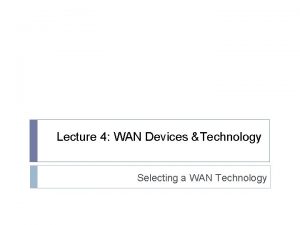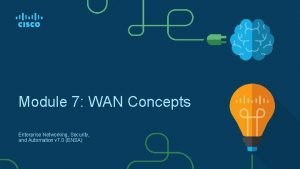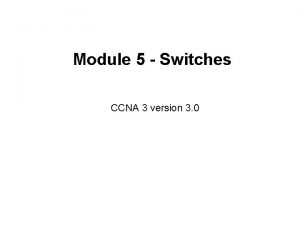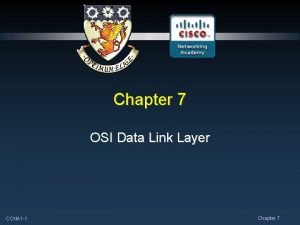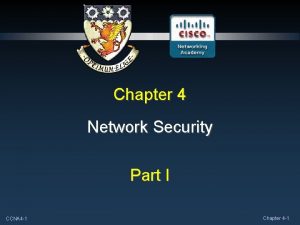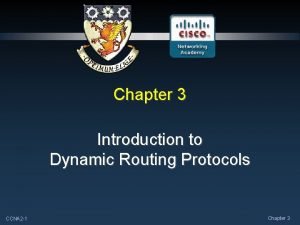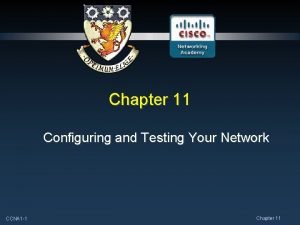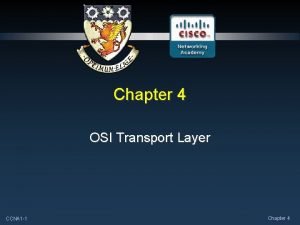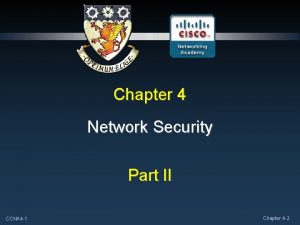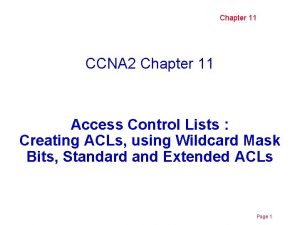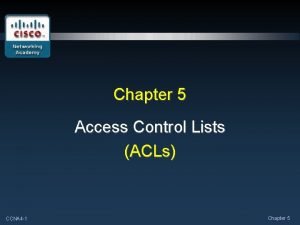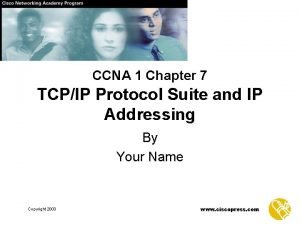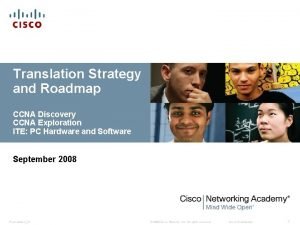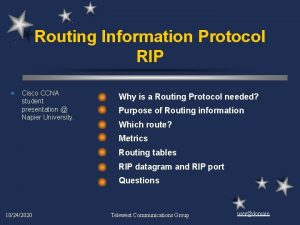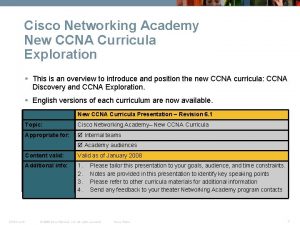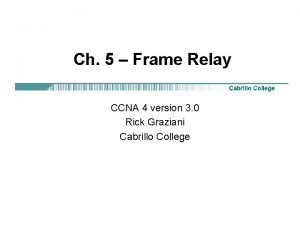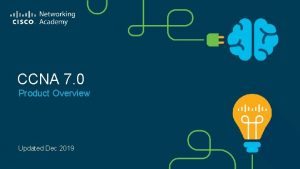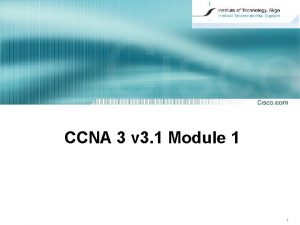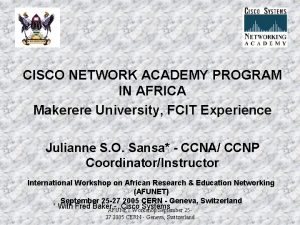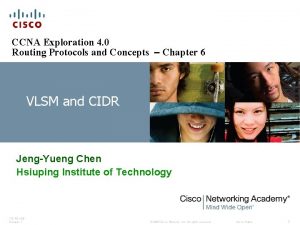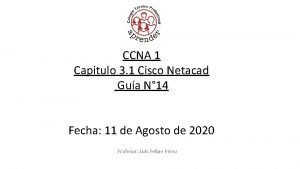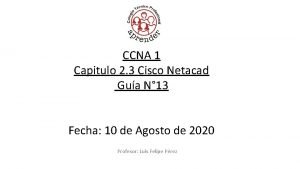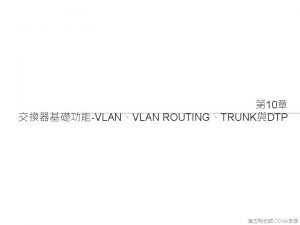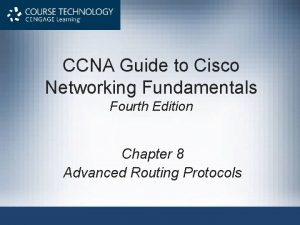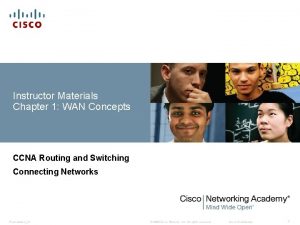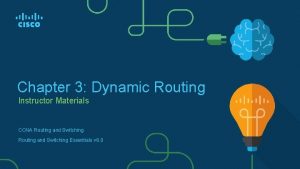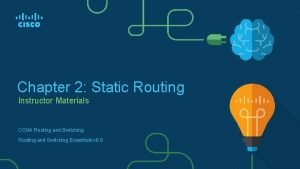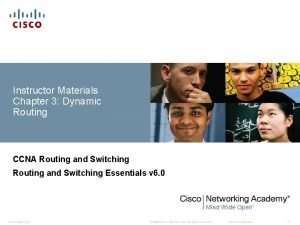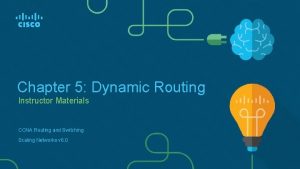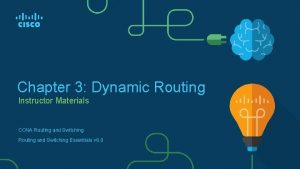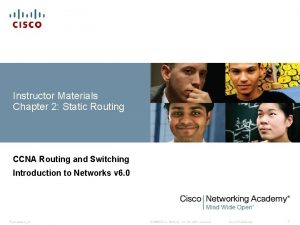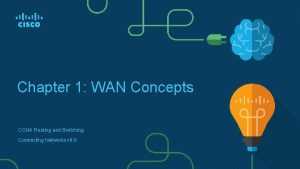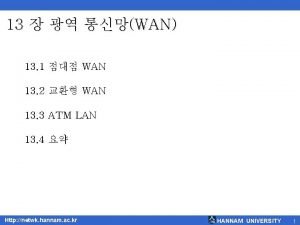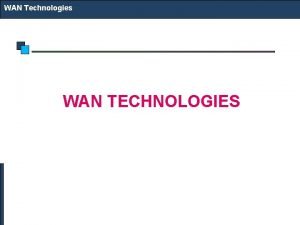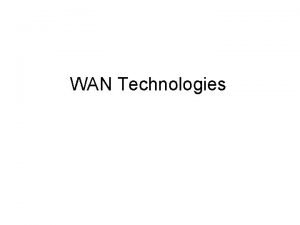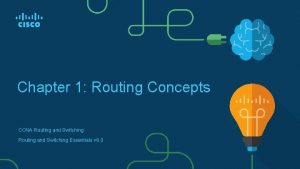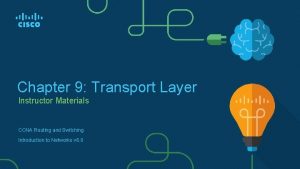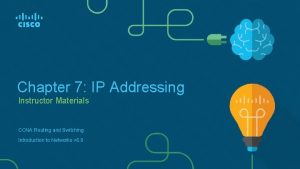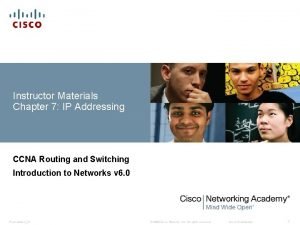Chapter 1 WAN Concepts Instructor Materials CCNA Routing














































- Slides: 46

Chapter 1: WAN Concepts Instructor Materials CCNA Routing and Switching Connecting Networks v 6. 0

Chapter 1: WAN Concepts Connecting Networks 6. 0 Planning Guide © 2016 Cisco and/or its affiliates. All rights reserved. Cisco Confidential 3

Chapter 1: WAN Concepts CCNA Routing and Switching Connecting Networks v 6. 0

Chapter 1 - Sections & Objectives § 1. 1 WAN Technologies Overview • Explain WAN access technologies available to small to medium-sized business networks. • Explain the purpose of a WAN. • Explain how WANs operate. § 1. 2 Selecting a WAN Technology • Select WAN access technologies to satisfy business requirements. • Describe WAN services available. • Compare private WAN technologies. • Compare public WAN technologies. • Select the appropriate WAN protocol and service for a specific network requirement. © 2016 Cisco and/or its affiliates. All rights reserved. Cisco Confidential 11

1. 1 WAN Technologies Overview © 2016 Cisco and/or its affiliates. All rights reserved. Cisco Confidential 12

Purpose of WANs Why a WAN? § A WAN operates beyond the geographic scope of a LAN. § WANs are used to interconnect the enterprise LAN to remote LANs in branch sites and telecommuter sites. § A WAN is owned by a service provider whereas a LAN is typically owned by an organization. § An organization must pay a fee to use the WAN service provider’s network services to connect remote sites. § Service providers provide links to interconnect remote sites for the purpose of transporting data, voice, and video. © 2016 Cisco and/or its affiliates. All rights reserved. Cisco Confidential 13

Purpose of WANs Are WANs Necessary? § Without WANs, LANs would be a series of isolated networks. § As organizations expand, businesses require the ability to communicate between geographically separated sites. For example: • Regional or branch offices of an organization need to be able to communicate and share data with the central site. • Organizations need to share information with other customer organizations. • Employees who travel on company business frequently need to access the corporate network. § In addition, consumers now commonly communicate over the Internet with banks, stores, and other providers of goods and services. © 2016 Cisco and/or its affiliates. All rights reserved. Cisco Confidential 14

Purpose of WANs WAN Topologies § Interconnecting multiple sites across WANs can involve a variety of service provider technologies and WAN topologies. There are four Common WAN topologies. § Point-to-Point topology • Employs a point-to-point circuit between two endpoints • Typically involves a dedicated leased-line connection such as a T 1/E 1 line. • Transparent to the customer network and appears to be a direct physical link between two endpoints § Hub-and-Spoke • Applicable when a private network connection between multiple sites is required • A single interface to the hub can be shared by all spoke circuits. • Spoke sites can be interconnected through the hub site using virtual circuits and routed subinterfaces at the hub. © 2016 Cisco and/or its affiliates. All rights reserved. Cisco Confidential 15

Purpose of WANs WAN Topologies (Cont. ) § Full Mesh • A disadvantage of the hub-and-spoke topology is that all communication has to go through the hub. • With a full mesh topology using virtual circuits, any site can communicate directly with any other site. • A disadvantage is the large number of virtual circuits that need to be configured and maintained. § Dual-homed Topology • Provides redundancy and load balancing however they are more expensive to implement than singlehomed topologies. • Requires additional networking hardware including routers and switches. • More difficult to implement since they require complex configurations. © 2016 Cisco and/or its affiliates. All rights reserved. Cisco Confidential 16

Purpose of WANs Evolving Networks § In slow economic times, many businesses focus on increasing their profitability by improving the efficiency of their existing operations – including establishing and managing their network. § To justify such a large expense, many companies expect their networks to perform optimally and to be able to deliver an increasing array of services and applications to support productivity and profitability. § This chapter will focus on a fictitious company called SPAN Engineering. § This topic will illustrate how SPAN’s network requirements change as the company grows from a small, local business into a global enterprise. © 2016 Cisco and/or its affiliates. All rights reserved. Cisco Confidential 17

Purpose of WANs Small Office § SPAN Engineering: • Environmental consulting firm (4 years) • Has developed a special process for converting household waste into electricity and is developing a small pilot project for a municipal government in its local area. • 15 employees: six engineers, four computer-aided drawing (CAD) designers, a receptionist, two senior partners and two office assistants • Small office uses a single LAN to share information between computers, support their Vo. IP phones, share peripherals, printer, and large-scale plotter • Connects to the Internet using DSL • Uses support services purchased from DSL provider for IT support. © 2016 Cisco and/or its affiliates. All rights reserved. Cisco Confidential 18

Purpose of WANs Campus Network § Five years later, SPAN Engineering has grown rapidly. The company was contracted to design and implement a full-sized waste conversion facility as well as other projects in neighboring municipalities and around the country. § The company is now classified as a small to medium-sized business with several hundred employees. § The company now occupies multiple floors of an office building. § The network has grown to several subnetworks which spans several floors of the building. § The business now has an in-house IT staff to support and maintain the network. © 2016 Cisco and/or its affiliates. All rights reserved. Cisco Confidential 19

Purpose of WANs Branch Networks § Another six years later, SPAN Engineering has been so successful, they have expanded their operation and have opened small branch offices closer to the project sites. § The company was required to implement a WAN in order for the remote sites to be able to access the data center which houses various databases and servers. § The branch offices that are in nearby cities use private dedicated lines through their local service provider. § Offices that are located in other countries must use the Internet for their WAN connection. © 2016 Cisco and/or its affiliates. All rights reserved. Cisco Confidential 20

Purpose of WANs Distributed Network § SPAN Engineering has now been in business for 20 years and has grown to thousands of employees distributed in offices worldwide. § The cost of the network and its related services is a significant expense. § To increase profitability, the company must reduce its operating expense. • What methods has the company used to reduce its operating costs? § To meet the new requirements, the network must provide the necessary converged service and secure Internet WAN connectivity to remote sites. § As seen in this example, network requirements of a company can change dramatically as a company grows over time. © 2016 Cisco and/or its affiliates. All rights reserved. Cisco Confidential 21

WAN Operations WANs in the OSI Model § WAN operations focus primarily on the physical and data link layer of the OSI Model. § Data link layer requirements include physical addressing, flow control and encapsulation. § WAN access standards are defined and managed by a number of recognized authorities: • TIA/EIA (Telecommunications Industry Association and the Electronic Industries Alliance) • ISO (International Organization for Standardization) • IEEE (Institute of Electrical and Electronics Engineers) § Layer 1 protocols describe how to provide electrical, mechanical, operational, and functional connects to the services of a communications service provider. § Layer 2 protocols define how data is encapsulated and the mechanisms for transferring the resulting frames. © 2016 Cisco and/or its affiliates. All rights reserved. Cisco Confidential 22

WAN Operations Common WAN Terminology § One primary difference between a WAN and a LAN is that a company must subscribe to an outside WAN service provider to use WAN carrier network services. § Terminology commonly used to describe WAN connections: • Customer Premises Equipment (CPE) – Consists of devices and inside wiring located on the enterprise edge connecting to a carrier • Data Communications Equipment (DCE) – Also called circuit-terminating equipment, the DCE consists of devices that put data on the local loop. The DCE primarily provides an interface to connect subscribers to a communication link on the WAN cloud. © 2016 Cisco and/or its affiliates. All rights reserved. Cisco Confidential 23

WAN Operations Common WAN Terminology (Cont. ) • Data Terminal Equipment (DTE) – The customer devices that pass the data from a customer network or host computer for transmission over the WAN. The DTE connects to the local loop through the DCE. • Demarcation Point – This is a point established in a building to separate customer equipment from service provider equipment. • Local Loop (“last mile”) – The actual copper or fiber cable that connects the CPE to the CO of the service provider. • Central Office (CO) – The CO is the local service provider facility or building that connects the CPE to the provider network. • Toll network – This consists of the long-haul, all-digital, fiber-optic communications lines and other equipment inside the WAN provider network. © 2016 Cisco and/or its affiliates. All rights reserved. Cisco Confidential 24

WAN Operations WAN Devices § There are many types of devices that are specific to WAN environments: • Dialup modem – Legacy WAN technology that converts (modulates) the digital signals produced by a computer into voice frequencies which are transmitted over the analog lines of the public telephone network to another modem for demodulation. • Access server – Legacy technology where the server controls and coordinates dialup modem, dial-in and dial-out user communications. • Broadband modem – A type of digital modem used with high-speed DSL or cable Internet service. Both operate in a similar manner to the voiceband modem, but use higher broadband frequencies and transmission speeds. © 2016 Cisco and/or its affiliates. All rights reserved. Cisco Confidential 25

WAN Operations WAN Devices (Cont. ) • CSU/DSU - Digital-leased lines require a CSU and a DSU. The CSU provides termination for the digital signal and ensures connection integrity through error correction and line monitoring. The DSU converts line frames into frames that the LAN can interpret and vice versa. • Router – Provides internetworking and WAN access interface ports that are used to connect to the service provider. • Core router/Multilayer switch – A router or multilayer switch that resides within the middle or backbone of the WAN. © 2016 Cisco and/or its affiliates. All rights reserved. Cisco Confidential 26

WAN Operations Circuit Switching • A circuit-switched network is one that establishes a dedicated circuit (or channel) between nodes and terminals before the users may communicate. • Circuit switching dynamically establishes a dedicated virtual connection for voice or data between a sender and a receiver. • Communication can't start until the connection is established through the service provider network. • Dialing a number to make a call is an example of circuit switching technology. • The two most common types of circuitswitched WAN technologies are the public switched telephone network (PSTN) and the Integrated Services Digital Network (ISDN). © 2016 Cisco and/or its affiliates. All rights reserved. Cisco Confidential 27

WAN Operations Packet Switching • In contrast to circuit switching, packet switching splits traffic data into packets that are routed over a shared network. • A circuit does not need to be established and many pairs of nodes can communicate over the same channel. • There are two approaches to packetswitched network link determination: • • Connectionless systems – Full addressing information must be carried in each packet. The Internet is an example of a connectionless system. • Connection-oriented systems – The network predetermines the route for a packet, and each packet only has to carry an identifier. An example of a connection-oriented system is Frame Relay (DLCIs are the identifiers). Packet switching costs less than circuit switching, however, latency and jitter are greater in packet-switching networks. © 2016 Cisco and/or its affiliates. All rights reserved. Cisco Confidential 28

1. 2 Selecting a WAN Technology © 2016 Cisco and/or its affiliates. All rights reserved. Cisco Confidential 29

WAN Services WAN Link Connection Options § There are several WAN access connection options that ISPs can use to connect the local loop to the enterprise edge. § Each option has distinct advantages and disadvantages as well as differences with technology, speed, and cost. § There are two ways an enterprise can obtain WAN access: • Private WAN infrastructure – Choices may include dedicated point-to-point leased lines, circuit-switched links such as PSTN or ISDN, and packet switched links such as Ethernet WAN, ATM, or Frame Relay. • Public WAN infrastructure – Service providers may offer broadband Internet using DSL, cable, or satellite access. Data traveling between corporate sites over a public WAN should be protected using VPNs. © 2016 Cisco and/or its affiliates. All rights reserved. Cisco Confidential 30

WAN Services Service Provider Network Infrastructure § Service provider networks are complex and consist mostly of high-bandwidth fiber-optic media, using either Synchronous Optical Networking (SONET) or Synchronous Digital Hierarchy (SDH) standard. § A newer fiber-optic media development for long-range communications is called dense wavelength division multiplexing (DWDM). • Multiplies the amount of bandwidth that a single strand of fiber can support • Enables bidirectional communications over one strand of fiber • Can multiplex more than 80 different channels of data onto a single fiber • Each channel can carry a 10 Gb/s multiplexed signal © 2016 Cisco and/or its affiliates. All rights reserved. Cisco Confidential 31

Private WAN Infrastructures Leased Lines § Point-to-point lines are usually leased from a service provider and are called leased lines. However, since they have been around since the 1950 s, they are sometimes referred to as: • Leased circuits • Serial link • Serial line • Point-to-point link • T 1/E 1 or T 3/E 3 lines § Leased lines vary in price depending on the bandwidth required and the distance between the two connected paths. § When permanent dedicated connections are required, a point-to-point link is used to provide a pre-established WAN communications path from the customer premises to the provider network. § In North America, service providers use the T- carrier system to define the digital transmission capacity of a serial copper media link. For example, a T 1 link supports 1. 544 Mb/s. © 2016 Cisco and/or its affiliates. All rights reserved. Cisco Confidential 32

Private WAN Infrastructures Dialup § Dialup WAN access may be required when no other WAN technology is available. § For example, a remote location could use modems and analog telephone lines to provide low capacity and dedicated switched connections. § Traditional local loops, which use copper cabling, transport binary computer data through the voice telephone network using a modem. § A modem modulates the binary data into an analog signal at the source and demodulates the analog signal to binary data at the destination. § WAN built with an on demand connection using a modem and the voice telephone network § The physical characteristics of the local loop and its connected to the PSTN limit the rate of the signal to less than 56 kb/s. © 2016 Cisco and/or its affiliates. All rights reserved. Cisco Confidential 33

Private WAN Infrastructures ISDN § Integrated Services Digital Network (ISDN) is a circuit-switching technology that enables the local loop of a PSTN to carry digital signals, resulting in higher capacity switched connections. § ISDN changes the internal connections of the PSTN from carrying analog signals to time-division multiplexed (TDM) digital signals. § TDM allows two or more signals, or bit streams, to be transferred as subchannels in one communication channel. § The ISDN connection may require a terminal adapter (TA) which is a device used to connect ISDN Basic Rate Interface (BRI) connections to a router. © 2016 Cisco and/or its affiliates. All rights reserved. Cisco Confidential 34

Private WAN Infrastructures ISDN (Cont. ) § There are two types of ISDN Interfaces: • Basic Rate Interface (BRI) – ISDN BRI provides two 64 kb/s bearer channels (B) for carrying voice and data and a 16 kb/s delta channel (D) for signaling, call setup and other purposes. • Primary Rate Interface (PRI) – In North America, PRI delivers 23 B channels with 64 kb/s and one D channel with 64 kb/s for a total bit rate of up to 1. 544 Mb/s. This includes some additional overhead for synchronization. § A common application of ISDN is to provide additional capacity as needed on a leased line connection. ISDN can also be used as a backup if the leased line fails. § Although ISDN is still an important technology for telephone service provider networks, it has declined in popularity due to DSL and other broadband services. © 2016 Cisco and/or its affiliates. All rights reserved. Cisco Confidential 35

Private WAN Infrastructures Frame Relay § Frame Relay is a Layer 2 non-broadcast multi-access (NBMA) WAN technology used to interconnect enterprise LANs. • Data rates of up to 4 Mb/s with some providers offering higher rates § A single router can be used to connect multiple sites using PVCs which can carry both voice and data traffic. § An edge router only requires a single interface, even when multiple virtual circuits are used. § Frame Relay creates PVCs which are uniquely identified by a data-link connection identifier (DLCI). The PVCs and DLCIs ensure bidirectional communication between one DTE device to another. © 2016 Cisco and/or its affiliates. All rights reserved. Cisco Confidential 36

Private WAN Infrastructures ATM § Asynchronous Transfer Mode (ATM) technology is capable of transferring voice, video, and data through private and public networks. • ATM is built on a cell-based architecture rather than on a frame-based architecture. • Cells are always a fixed length of 53 bytes. • ATM cells contain a 5 -byte ATM header followed by 48 bytes of ATM payload. § Small fixed-length cells are well-suited for voice and video traffic. § A typical ATM line needs almost 20% greater bandwidth than Frame Relay to carry the same volume of network traffic. § When the cell is carrying segmented network layer traffic, the overhead is higher since the ATM switch must be able to reassemble the packets at the destination. © 2016 Cisco and/or its affiliates. All rights reserved. Cisco Confidential 37

Private WAN Infrastructures Ethernet WAN § Thanks to newer Ethernet standards using fiber-optic cables, Ethernet is now a reasonable WAN access option. • The original maximum cable length for Ethernet was one kilometer. • With fiber-optic cable, the maximum length is 5 km using IEEE 10000 Base-LX, and 70 km using IEEE 1000 BASE-ZX standards. § Service providers now offer Ethernet WAN service using fiber-optic cabling which provide several benefits: • Reduced expenses and administration • Easy integration with existing networks • Enhanced business productivity § Ethernet WANs are commonly being used to replace Frame Relay and ATM WAN links. © 2016 Cisco and/or its affiliates. All rights reserved. Cisco Confidential 38

Private WAN Infrastructures MPLS § Multiprotocol Label Switching (MPLS) is a multiprotocol high-performance WAN technology that directs data from one router to the next. • MPLS is based on short path labels rather than IP network addresses. • It is called Multiprotocol since it has the ability to carry any payload including IPv 4, IPv 6, Ethernet, ATM, DSL, and Frame Relay traffic. • It uses labels which tell the router what to do with a packet. § Notice in the figure to the left that different sites can connect to the MPLS cloud using different access technologies. § MPLS is primarily a service provider WAN technology. § MPLS can support a wide range of WAN technologies including T-carrier / E-carrier links, Carrier Ethernet, ATM, Frame Relay, and DSL. © 2016 Cisco and/or its affiliates. All rights reserved. Cisco Confidential 39

Private WAN Infrastructures VSAT § All private WAN technologies discussed so far used either copper or fiber-optic media. § What if an organization needed connectivity in a remote location where there are no service providers that offer WAN service? § Very small aperture terminal (VSAT) is a solution that creates a private WAN using satellite communications. § A VSAT is a small satellite dish used to create a private WAN that provides connectivity to remote locations. § The satellite is in geosynchronous orbit in space. The signals travel approximately 35, 786 kilometers to the satellite and back. © 2016 Cisco and/or its affiliates. All rights reserved. Cisco Confidential 40

Public WAN Infrastructures DSL § DSL is an always-on connection technology that uses existing twisted-pair telephone lines to transport high-bandwidth data, and provides IP services to subscribers. § A DSL modem is required which converts an Ethernet signal from the user device to a DSL signal, which is transmitted to the central office. § Multiple DSL subscriber lines are multiplexed into a single high-capacity link using a DSLAM at the provider location. § DSL is a popular choice for IT departments to support home workers. § A subscriber must first connect to an ISP and then an IP connection is made through the Internet to the enterprise network. © 2016 Cisco and/or its affiliates. All rights reserved. Cisco Confidential 41

Public WAN Infrastructures Cable § Network access is available from many cable television providers (using coaxial cable) which allows for greater bandwidth than the conventional telephone local loop. § Cable modems provide an always-on connection and a simple installation. § A subscriber connects a computer or a LAN router to the cable modem, which translates the digital signals into broadband frequencies used for transmitting on a cable television network. § The cable modem termination system (CMTS), which is a component located at the local cable TV office (headend), sends and receives digital cable modem signals on a cable network and is necessary for providing Internet services to subscribers. © 2016 Cisco and/or its affiliates. All rights reserved. Cisco Confidential 42

Public WAN Infrastructures Wireless § Until recently, one limitation of wireless access has been the need to be within the local transmission range (typically less than 100 feet) of a wireless router or a wireless modem. The following new developments are changing this: • Municipal Wi-Fi – Many cities have begun setting up municipal wireless networks for free or for substantially less than broadband. • Wi. MAX (IEEE 802. 16) – Worldwide Interoperability for Microwave Access (Wi. MAX) is a new high-speed broadband technology that is just beginning to come into use. Wi. MAX provides broad coverage similar to a cell phone network rather than through Wi-Fi hotspots. Wi. MAX operates similar to Wi-Fi, but at higher speeds and over longer distances. © 2016 Cisco and/or its affiliates. All rights reserved. Cisco Confidential 43

Public WAN Infrastructures Wireless (Cont. ) • Wi. MAX uses a network of Wi. MAX towers that are similar to cell phone towers. Subscribers must be within 30 miles of a tower. • Satellite Internet – Typically used by rural users where cable and DSL are not available. A VSAT provides two-way (upload and download) data communications. The upload speed is about one-tenth of the 500 kb/s download speed. Cable and DSL have higher download speeds, but satellite systems are about 10 times faster than analog modems. © 2016 Cisco and/or its affiliates. All rights reserved. Cisco Confidential 44

Public WAN Infrastructures 3 G/4 G Cellular § Increasingly, cellular service is another wireless WAN technology being used to connect users and remote locations where no other WAN access technology is available. § Phones, tablet computers, laptops, and even some routers can communicate through to the Internet using cellular technology. § These devices use radio waves to § There are two common cellular industry terms: • 3 G/4 G Wireless – Abbreviation for 3 rd and 4 th generation cellular access. • Long-Term Evolution (LTE) – Refers to a newer and faster technology and is considered to be part of the fourth generation (4 G) technology. communicate through a nearby mobile phone tower. The device has a small radio antenna, and the provider has a much larger antenna sitting at the top of the tower somewhere within miles of the phone. © 2016 Cisco and/or its affiliates. All rights reserved. Cisco Confidential 45

Public WAN Infrastructures VPN Technology § Due to security risks, VPNs are needed when a teleworker or a remote office uses a broadband service to access the corporate WAN over the Internet. § A VPN is an encrypted connection between private networks over a public network, such as the Internet. § Instead of using a dedicated Layer 2 connection such as a leased line, a VPN uses virtual connections called VPN tunnels, which are routed through the Internet from the private network of the company to the remote site or employee host. © 2016 Cisco and/or its affiliates. All rights reserved. Cisco Confidential 46

Public WAN Infrastructures VPN Technology (Cont. ) § There are several benefits to using VPNs: • Cost savings • Security • Scalability • Compatibility with broadband technology § There are two types of VPN access: • Site-to-site VPNs – Connects entire networks to each other; for example, they can connect a branch office network to a company headquarters network. • Remote-access VPNs – Enables telecommuters, mobile users, and extranet consumers to access a company network securely over the Internet. © 2016 Cisco and/or its affiliates. All rights reserved. Cisco Confidential 47

Selecting WAN Services Choosing a WAN Link Connection § There are many factors to consider when choosing an appropriate WAN connection. Network administrators must answer numerous questions including: • What is the purpose of the WAN? • Will the enterprise connect local branches in the same city area, connect remote branches, or connect to a single branch? • Will the WAN be used to connect internal or external employees or customers? • What is the geographic scope? • Is the WAN local, regional, or global? • Is the WAN one-to-one (single branch), one-to-many branches, or many-to-many (distributed)? • What are the traffic requirements? • What type of traffic must be supported? • What are the quality and performance requirements? • What Quality of Service is required? © 2016 Cisco and/or its affiliates. All rights reserved. Cisco Confidential 48

Selecting WAN Services Choosing a WAN Link Connection (Cont. ) § Should the WAN use private or public infrastructure? • Private infrastructure – offers the best security • Public Internet infrastructure – not as secure, but offers the most flexibility and lowest ongoing expense § For a private WAN, should it be dedicated or switched? § For a public WAN, what type of VPN access is required? § Which connection options are available locally? § What are the costs of the connection options available? © 2016 Cisco and/or its affiliates. All rights reserved. Cisco Confidential 49

Selecting WAN Services Lab – Researching WAN Technologies § In this lab, you will be required to investigate the cost and availability of purchasing a dedicated T 1 Internet connection for your home or business. © 2016 Cisco and/or its affiliates. All rights reserved. Cisco Confidential 50

1. 3 Summary © 2016 Cisco and/or its affiliates. All rights reserved. Cisco Confidential 51

Summary Conclusion • Explain WAN access technologies available to small to medium-sized business networks. • Select WAN access technologies to satisfy business requirements. © 2016 Cisco and/or its affiliates. All rights reserved. Cisco Confidential 52

 Wan technologies ccna
Wan technologies ccna Difference between channel routing and reservoir routing
Difference between channel routing and reservoir routing Static routing and dynamic routing
Static routing and dynamic routing Continuity equation hydrology
Continuity equation hydrology Difference between clock routing and power routing
Difference between clock routing and power routing Advantages of private wan
Advantages of private wan Lab 4-1: routing concepts and protocols
Lab 4-1: routing concepts and protocols Researching wan technologies
Researching wan technologies Internet-based wan connectivity options
Internet-based wan connectivity options Wan concepts
Wan concepts Ccna 3 chapter 1
Ccna 3 chapter 1 What is a function of the data link layer ccna
What is a function of the data link layer ccna Ccna 4 chapter 4
Ccna 4 chapter 4 Modern network security threats
Modern network security threats Ccna 4 chapter 1
Ccna 4 chapter 1 Ccna chapter 7
Ccna chapter 7 Ccna 2 chapter 3
Ccna 2 chapter 3 Ccna chapter 11
Ccna chapter 11 Ccna 1 chapter 4
Ccna 1 chapter 4 Ccna 4 chapter 4
Ccna 4 chapter 4 Ccna 2 chapter 11
Ccna 2 chapter 11 Ccna 4 chapter 5
Ccna 4 chapter 5 Ccna 1 chapter 7
Ccna 1 chapter 7 Favourite cars
Favourite cars Both useful and harmful materials
Both useful and harmful materials Man made map
Man made map Differentiate adopting materials and adapting materials
Differentiate adopting materials and adapting materials Direct materials budget with multiple materials
Direct materials budget with multiple materials Ccna drugs
Ccna drugs Ccna roadmap
Ccna roadmap Sybex ccna
Sybex ccna Rip student
Rip student Cisco ccna exploration
Cisco ccna exploration Frame relay ccna
Frame relay ccna Ccna exploration network fundamentals
Ccna exploration network fundamentals Https//assessmentlauncher.secure.nl
Https//assessmentlauncher.secure.nl Ccna module 1
Ccna module 1 Osi model ccna
Osi model ccna Ccna makerere university
Ccna makerere university Eigrp ccna
Eigrp ccna Ccna voice 640-461 pdf
Ccna voice 640-461 pdf Ccna exploration 4
Ccna exploration 4 Netcad
Netcad Netacad cisco
Netacad cisco Asymmetric vlan
Asymmetric vlan Ccna 640-802
Ccna 640-802 Ccna guide to cisco networking
Ccna guide to cisco networking
